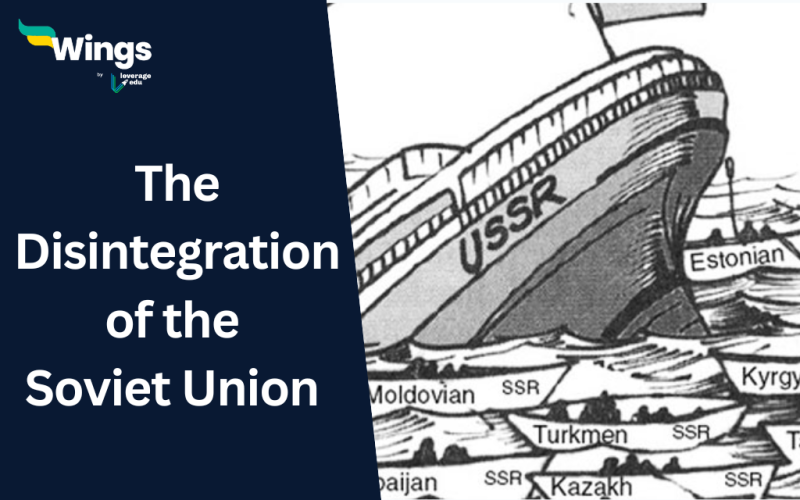The dissolution of the Soviet Union is an important part of the UPSC IAS exam syllabus. This topic is covered in the World History section of the Mains General Studies Paper 1 syllabus and the General Studies Paper -1 section of the UPSC Prelims syllabus.
Table of Contents
When did the Soviet Union break down?
The Soviet Union disintegrated on December 25, 1991. On a global scale, it was a significant event. It signalled the end of the Cold War and the breakup of the USSR (Soviet Union). It gave birth to several new independent republics in Central Asia and the Baltic region, as well as the Russian Federation.
Also Read: The Cold War Summary | UPSC World History Notes
History of the USSR
Prior to its demise in 1991, the Union of Soviet Socialist Republics (USSR) had 15 republics. Russia was one of the republics. Following is a list of the nation’s member republics.
1. Armenia
2. Azerbaijan
3. Belarus
4. Estonia
5. Georgia
6. Kazakhstan
7. Kyrgyzstan
8. Latvia
9. Lithuania
10. Moldova
11. Russia
12. Tajikistan
13. Turkmenistan
14. Ukraine
15. Uzbekistan
Issues with the USSR
- Authoritarian and bureaucratic system.
- An absence of democracy.
- Lack of freedom of speech.
- Communist, one-party government that is not answerable to the people.
- Russian dominance and the disregard for other republics’ interests.
- Defence spending is high while technology and infrastructure spending is low.
Soviet Union Collapse Reasons
Economic Weakness
The weakness of the economy was the major cause of dissatisfaction among the people in the USSR. There was a severe shortage of consumer items. The reasons for economic weakness were the following.
- Huge military spending.
- Maintenance of satellite states in Eastern Europe.
- Maintenance of the Central Asian Republics within the USSR.
Unaccountability in politics
For roughly 70 years, the communist party regime (single-party rule) became authoritarian. Corruption, nepotism, and a lack of transparency were all prevalent. Gorbachev’s decision to allow multi-party elections and establish a presidency for the Soviet Union kicked off a slow process of democratisation that eventually destabilised Communist control and contributed to the Soviet Union’s demise.
Gorbachev’s reforms
When people began to enjoy greater freedom as a result of Mikhail Gorbachev’s reforms, they demanded more. The demand grew into a powerful force that was difficult to control. The people were eager to catch up with the West.
Nationalism was on the rise.
The main and immediate reason for the fall of the USSR was the rise of nationalism in nations like Russia, the Baltic republics (Estonia, Latvia, and Lithuania), Ukraine, Georgia, and others. Instead of in the Central Asian republics, the national sentiment was strong in the USSR’s wealthier regions. Ordinary people in prosperous republics didn’t like to pay a big price to uplift the backward Central Asian republics.
Disintegration of the USSR: Major Events
Crisis in the socialist bloc: Protests against their own governments and the USSR erupted in many East European nations. Without the USSR’s timely and appropriate intervention, communist governments in the second world fell one after another.
The Fall of the Berlin Wall: Following World War II, Germany was split between the capitalist Western regimes and the socialist USSR. The USSR’s collapse was one of many events that followed the fall of Berlin.
Economic and political reforms in the USSR: Gorbachev recognised the political and economic issues facing the country and launched a number of reforms to help the economy. Contrary to communist principles, this was more closely related to the market economy. Many Soviet communist leaders opposed Gorbachev’s reforms. In 1991, they encouraged a coup.
Opposition to the Coup: Boris Yelsin, the popularly elected president of the Russian Republic, led the opposition against the coup and the centralised rule of the USSR. The phrase “freedom for republics” was adopted. The hard-line Communist elite sought to thwart Gorbachev’s reform agenda, while Boris Yeltsin and the pluralist movement pushed for democratic reform and quick economic change.
Power Shift: Republics like Russia, Ukraine, and Belarus emerged as powerful states as the Soviet Union’s centre of power shifted. They declared that the Soviet Union had been disbanded.
Note: It was not a decision that was reached in unison to divide the USSR into separate republics. Central Asian nations desired to stay within the USSR. But the decision was taken against their wishes.
Hope you have gotten all the relevant information about the Cold War! If you want to know more about topics like this, then visit our general knowledge page! Alternatively, you can also read our blog on general knowledge for competitive exams!
 One app for all your study abroad needs
One app for all your study abroad needs













